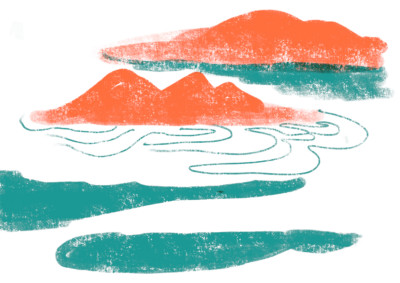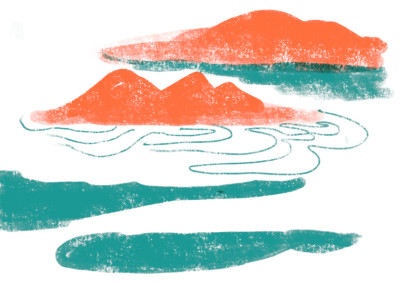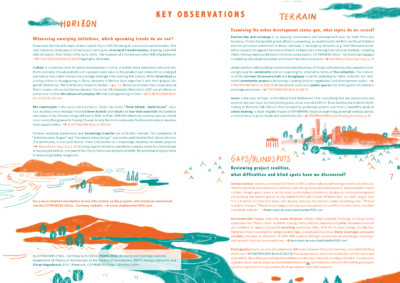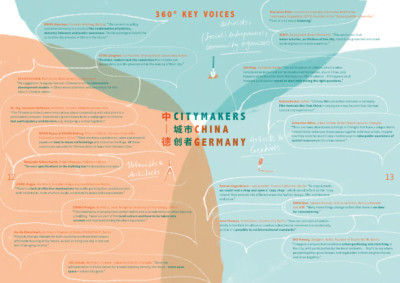Witnessing emerging initiatives, which upcoming trends do we see?
Essen won the title of Europe’s Green Capital City in 2017, honoring its successful transformation. The vast industrial landscape in China is just starting its structural transformation, drawing a parallel with Germany’s Ruhr Valley in the early 1960s. The example of Xi’an Dahua Cotton Mill refurbishment (STADTMACHER-Blatt #2 2017/4) highlights the trend.
Culture is a common wish for urban development in China. A middle-class consumer culture of aesthetic economy (Visual aesthetics of a product adds value to the product and makes it) has emerged and tabula rasa urban renewal increasingly endangers the existing folk culture. While street food as a living culture is disappearing in China, students in Weimar have imported it with their project, Angerollt (Rolled Up). The Oral history Project in Wuhan (p. 22), Bendi-Local team’s documentation of Xi’an’s street culture and Nantou Ancient City at the 7th Shenzhen Biennale in 2017 are all efforts to preserve or archive the culture of everyday life that is disappearing in China (STADTMACHER-Blatt #2, #3).
The countryside is the social and local focus. Under the motto “Think Global – Build Social”, Austrian architect Anna Heringer finished three hostels with local and low-tech materials like bamboo and adobe in the Chinese village of Baoxi in 2016. In Xi’an, EURASIA University summer courses visited rural county Wangjiawan in Foping, Shanxi, to help the local community find innovative local development opportunities (STADTMACHER-Blatt #3, 2017/10).
Formats enabling experiments and knowledge transfer are of further interest. The translation of “Schichten einer Region” and “Handbook Urban Design”, two books published by Prof. Christa Reicher (TU Dortmund), is one such format. From CityToolBox as a knowledge database for urban projects (Ways of Learning City, p. 30) to using a game format to coordinate complex needs in school design in the project GENIUS, one part of the City of Tomorrow projects of BMBF, the potential of digital tools is increasingly being recognized.
Examining the urban development status quo, what topics do we record?
Partnership and exchange is an ongoing urbanization and development topic for both China and Germany. China’s footprint in global affairs is expanding, as manifested in the Belt and Road Initiative and infrastructure investment in Africa. Germany is developing networks (e.g. Netzwerk Architektur Export, NAX) to support German architects and planners entering international markets, including China. Among numerous bilateral initiatives and projects, CITYMAKERS China – Germany has engaged in enabling individual citymakers and move from ideas to actions. (See Ways of Learning Cities, p. 30)
Urban dwellers with isolating routines (standardised way of living) and cybersecurity concerns increasingly long for community and are searching for alternative forms of the collective. The relevance of the German Genossenschaft and Baugruppe is worth exploring for China. In Berlin, the holzmarkt community project is becoming a testing field for regulations and development modes (STADTMACHER-Blatt #3 2017/10); in Dortmund, turns local public spaces into melting pots of collective exchange and action (STADTMACHER-Blatt #2 2017/4).
Green is the colour of hope. In the Global Field (Weltacker) Club, everything that one person eats and wears in one year must be statistically grown on an area of 2,000 m2. From InselGarten in Berlin Schöneberg to Ecoland Club (China’s first community gardening project) and from a feasibility study of urban farming in local neighborhoods to UPFARMING research examining potential rooftop spaces, a central focus is green inside and outside the city. (STADTMACHER Urban Farming Incubator, p. 26).
GAPS AND BLINDSPOTS
Reviewing project realities, what difficulties and blind spots have we discovered?
Urban renewal remains a controversial theme in China, where culture and existing contexts are often sacrificed to political and commercial interests under the guise of urban development. Reconstructed historical sites, living in green areas or on the water are branding instruments, driving real estate prices upward and pushing low-income groups to city outskirts that lack a basic infrastructure. As LIANG Jingyu said: “It is a tradition in China that every new dynasty destroys the old and creates something new.” Michael Leischner answers: “Please let your impressive city wall stay and do not sacrifice it to short-term, transient capitalistic bubbles.”
Environmental issues, especially waste disposal, remain China’s greatest challenge, as shown in the impressive film “Plastic China” by WANG Jiuliang. Policy, industry interests and public awareness have not yet combined to support successful recycling systems in China. With this in mind, Aobag, the initiative that gives citizens cashback for using reusable bags, is especially innovative. Water shortages and water security also deserve attention. LE ShUI XING explores Beijing’s waterscape via strollology, revealing a sinking water level and water pollution.
Participation marks an area of fundamental difference between China and Germany. Journalist SHI Ming points out (STADTMACHER-Blatt #3) that societal issues need communication, but the space and channels for describing and solving the problems are missing or blocked, creating a dilemma. Contemporary global issues can no longer be confronted without citizen participation and once the wish to participate has been expressed, its organization, form and degree need to be explored.
ZHANG Zhen, CITYMAKERS China – Germany Guest Editor, Research and Teaching Assistant, Department of Theory of Architecture at the Faculty of Architecture, RWTH Aachen University.
Silvan Hagenbrock, B.Sc. Urbanistik, CITYMAKERS China – Germany Editor








